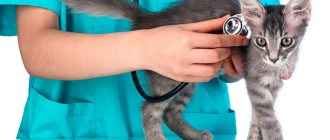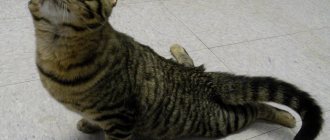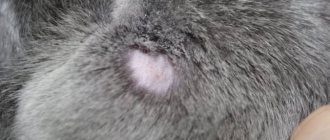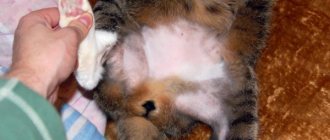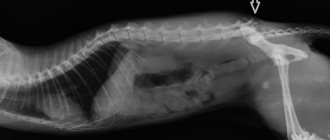When to contact a veterinarian
The veterinarian will examine the animal and prescribe the necessary tests. As a result, it may turn out that the pet has diseased kidneys. Along with trembling, the pet becomes more aggressive and its behavior changes.
There is another reason why trembling may begin. And she's pretty serious. This is rhinotracheitis. This disease can affect both an adult animal and a kitten. It can develop in representatives of any breed. With this disease, the pet's respiratory system is affected.
In order to identify a disease in your pet as early as possible and begin to treat it, it is better to show it to the veterinarian as soon as you become suspicious and concerned. If your suspicions are not confirmed, you can calm down, and if they are confirmed, you will have a better chance that your pet will recover faster, and this will not affect his health.
A particularly observant owner will always be able to identify any changes that happen to his mustachioed pet. How to react to them?
The owner’s first thought will be to contact a veterinarian for an examination and determine the cause of the disease. But is it always necessary to seek qualified help? Frightening symptoms may not mean that the cat has any disease.
READ Why Siamese cats are popular with thousands of breeders
If the owner, after analyzing his pet’s trembling on his own, does not find an explanation for it, he will have to immediately contact a specialist at the nearest veterinary clinic. As the animal begins to tremble, its behavior may change; overnight, a beloved cat may become aggressive. In addition to the reasons described above that cause tremors in a cat in a lying position, there are many other less harmless reasons that cause tremors.
These include:
- The cat has helminths.
- Lack of vitamins in the cat's body (especially calcium and vitamin B).
- Diseases of internal organs (in particular the kidneys - the presence of urolithiasis in the animal).
The veterinarian will send the animal along with the owner to undergo all the necessary tests and an ultrasound of the internal organs, and then give recommendations on the necessary treatment.
This is interesting: Instructions for using Febtal for cats
Causes of trembling in a cat
The cat was simply frozen. It would seem that cats can really suffer from the cold, since they can be outside even in the winter? However, in fact, cold is the worst enemy for all living organisms. An animal that has become hypothermic can not only catch a cold, but also become seriously ill.
A problem of this nature can be solved in the following way:
- Do not let the animal go outside in winter.
- Buy clothes for cats in specialized stores, or make them yourself.
If a cat, coming from the street, lies down on the floor, on the sofa, or somewhere else, and at the same time trembles strongly, he is simply very cold during a walk. It is also worth keeping an eye on the animal and during this very walk, it may begin to shake while still on the street.
The cat became scared. The person who believes that cats are the most fearless animals is deeply mistaken. They may show this with all their imperturbable appearance, attacking the feet of their owners, damaging the owner’s property, however, in the very depths of their souls, these animals are very vulnerable and timid creatures: you can scare a cat as easily as possible.
Due to experiencing severe fright, or a stressful situation, which, for example, may be associated with a change of residence, a change in food, or the appearance of a stranger in the house (in fact, there are a huge number of reasons). In this case, a nervous shock may occur in the cat’s body, the result of which will be trembling or nervous chills.
The cat begins to literally shake with fear. What to do in this case? It would be most advisable to try to eliminate the cause in the form of that same provoking factor. The owner will have to try to calm his beloved pet, stroke it, caress it. Every person knows that fear and stress can be eliminated through the use of positive emotions.
If such a cat's tremors are ignored, in the future such an action may lead to a change in the cat's behavior, which may result in habits that irritate the owner.
The cat experiences joy and positive emotions. The pet may tremble while lying down from an excess of positive emotions. The mustachioed man could miss him very much during the whole day of absence of the owner of the house. And when the owner comes home, the cat rushes to climb onto his lap and settle down there comfortably in a ball or stretched out to his full cat height.
Trembling when lying down in this case means exclusively a test of pleasure from the fact that its owner is near him
The cat lies down on the floor after eating and begins to tremble. Veterinarians say that a full stomach can bring a cat to this state; the animal’s muscles simply contract.
The cat is experiencing sexual arousal. When an animal is in such a state, it may experience a tremor of the whole body, which in turn is due to the fact that the cat’s senses are very heightened at a given moment in time and its excitement reaches its extreme measure. In the event that the owner does not intend to breed cats, the correct way to get rid of tremors of this nature will be castration of the mustachioed one.
If the cat owner has determined that the cat has any of these reasons, then there is no need to worry in this case: the cat will calm down and the trembling will go away by itself.
The cat's paws are shaking
There are many reasons why cats tremble. This may be a manifestation of fear, the influence of cold, an uncomfortable body position.
Puberty in cats is one of the most common causes. After sterilization, the trembling stops. In cats, this phenomenon can occur before estrus. If symptoms persist after surgery, be sure to contact your veterinarian.
A lack of vitamin B can also cause tremors in your pet. In this case, buy brewer's yeast for your cat. They are sold at any pet store.
Don't worry if your cat twitches in his sleep - this is a normal phenomenon that occurs during sleep.
Trembling paws means a lack of calcium in the body. To cure your cat, start giving him vitamin complexes with microelements. Typically, such courses last 10 days.
Kidney diseases can also cause trembling in the paws. In this case, give the cat the drug “Cat Erwin”. This medicine is made from natural ingredients and is absolutely harmless to animals. It will relieve inflammation and have a diuretic effect.
Trembling limbs can be a symptom of a serious illness, for example, rhinotracheitis. In this case, you need to contact a veterinarian.
But it is better not to self-medicate, but to immediately contact a veterinarian.
An attentive owner of a mustachioed, striped, and perhaps completely hairless meowing pet (we are talking about) will definitely notice the changes that are happening to his animal. But how to react to them? Should you always bother your veterinarian? Or perhaps the symptoms that frighten us are not some kind of terrible pathology?
Today we invite you to talk about why a cat or kitten may tremble, what diseases such trembling can be a symptom of, and how to help an animal in this situation...
There can be many reasons for trembling and these will be discussed further.
After all, the most important thing in this situation is to be able to understand the reasons for the appearance of this symptom.
It is also important to understand at what point you should seek help.
The cat will have poor coordination and may experience tremors. This is a normal reaction to medications. Usually such trembling does not last long and does not carry anything bad.
Advice!
Observe your pet, do not leave her alone and monitor all changes occurring in her condition. If everything is in order, then after a while the trembling will pass.
Frozen
Cats are very warm-blooded animals and the optimal room temperature for them is about 20 degrees. All cats tremble even after the usual, not to mention any temperature changes.
As you know, body temperature decreases during sleep. The same thing happens while under anesthesia, that is, the cat may simply freeze, which will provoke trembling.
Advice!
To prevent this from happening, you need to place your pet next to a warm radiator or place a heating pad near it. You can try to cover your pet with a warm blanket, but most likely this will not be successful, because animals behave very restlessly when they come out of anesthesia.
The blanket is in the way
Some animals do not perceive any foreign objects on their bodies. One of these (foreign to the animal) things is the one that is worn after the sterilization procedure.
By trembling, the animal may try to remove the blanket and thereby relieve itself of discomfort.
Attention!
Some cats shake when they are stressed, and the cause of discomfort may be the same blanket.
In this case, you can try to wait until the cat calms down or consult a veterinarian about removing the blanket for a short period of time. If the doctor approves this step, then it is important to ensure that the cat does not dirty or lick it in any way. At this time, you need to keep an eye on your pet.
So, what could be the reason why a cat’s paws are trembling? And there are many reasons for this condition. For example, paw tremors may occur in a cat during puberty; Usually after mating or castration it goes away on its own.
And in females, this symptom can appear immediately before the onset of estrus, after which everything goes away. Another reason for trembling paws in cats is a lack of vitamin B, which is responsible for the condition of the nervous system.
Calcium deficiency can also trigger this phenomenon. But sometimes the reason why a cat’s paws are trembling can be a serious illness (for example, rhinotracheitis).
Reasons why a cat trembles
Tremor or trembling in a pet is not always a sign of illness. If a cat is trembling, then it is almost impossible not to notice this state of the animal. There are several main reasons that can cause a pet to tremble in apparent absolute health:
- an animal's reaction to an external stimulus represented by cold. This reason is the most harmless, but can cause a number of quite serious consequences, including severe hypothermia of a pet. It is especially important to control the temperature in the room when keeping hairless breeds and cats with short hair. In cool weather, it is necessary to reduce walks with the animal to a minimum or completely eliminate its stay on the street;
- an animal's reaction to severe fright or any stressful situation. Quite often, this situation arises when there is a sudden change in diet, the appearance of strangers or unfamiliar animals in the house, as well as when being transported to a new place of residence. In this case, it is enough to eliminate all factors that provoke trembling as quickly as possible and calm the pet;
- reaction to a joyful event. Trembling in an animal can also cause quite positive emotions, including joy from the appearance of the owner or pleasure from games, affection and receiving favorite foods;
- reaction to sexual arousal. The appearance of fairly distinct trembling can be caused by a state of sexual arousal in a cat or a cat in heat. In almost all representatives of the cat family, all senses are very characteristically heightened and behavioral characteristics change greatly during the period of sexual arousal, therefore, it is advisable to sterilize or castrate animals not intended for breeding;
- natural processes. Actively occurring in the body of a sleeping pet, they can also be accompanied by trembling of the body and limbs.
Important! Particular attention is required to frequent, quite strong tremors of the body and limbs, which occur in a pet regularly and for no apparent reason.
In this case, it is necessary to deliver the cat to a veterinary institution as quickly as possible, where a full range of basic, most informative diagnostic measures will be carried out aimed at identifying the cause of the pathological condition.
The animal got scared
The second simplest explanation for trembling in an animal is intense fear. Such a tremor is invisible to the eye, but is felt as a small vibration in the pet’s body if you place your palm on it. In this case, it is worth finding out why the cat had this reaction. The reasons may be different:
READ How to treat a cat with a third eyelid. Causes of third eyelid prolapse in cats and treatment methods. Features of treatment of pregnant cats and kittens
- a change of scenery;
- the appearance of a new person in the house;
- presence of a foreign animal nearby;
- new item;
- unfamiliar smell.
Common medications for treating ear diseases in cats
Ear diseases in cats: symptoms and treatment
Timely and correct treatment contributes to the rapid recovery of kittens and cats, without serious complications.
| Diseases | How to treat |
| Otitis | Drops Surolan, Bars, Amitrazine, Otoferonol, Otibiovin, Anadin, Lakrikan, Serco, Amitrazine (fungal otitis media). |
| Ear scabies | Stronghold, Frontline, Otidez, Surolan, KiSka. |
| Ear mites | Tsipam, Surolan, Amit, Demos, Dekta, KiSka. |
| Dermatitis | Surolan, Serco. |
| Fleas | Dana-15, Beaphar, Hartz, Inspector, Bars, Frontline, Advantage, Barrier, Stronghold, Delix. |
| Hematoma of the auricle | Otodepin drops, Troxevasin and Troxerutin ointment. |
Joyful emotions
Tremor in cats is sometimes a symptom of great joy. For example, an animal missed its owner for a long time, being alone at home, and when it lies on his lap, it trembles. Separately, it is worth considering cases when the pet begins to shake in its sleep. Most likely, he is dreaming of some fascinating or emotional plot. To stop the trembling, simply wake up the animal.
Another manifestation of trembling is sexual arousal. A mature animal, during a period suitable for reproduction, can become so overexcited that it manifests itself in the form of a tremor. Such emotional stress is very high, so it is worth giving the animal to satisfy its sexual instinct. If you do not plan to breed cats, you need to subject it to the procedure of castration or sterilization.
Trembling is a natural reaction of an animal's body in response to changes in air temperature. A cat shivers for a variety of reasons, often simply wanting to stay warm in anticipation of catching prey. However, a good half of the possible causes come down to the presence of infections of various etiologies. Then it is important to be able to distinguish ordinary trembling from serious internal problems, dangerous convulsive conditions. Let's try to figure out together in what cases you should immediately run for help.
Possible diseases
What are the top three ear problems for cats? There are three of them - inflammation (otitis), sulfur plug and mites.
Inflammation
Ear inflammation is the most common. The cat begins to shake its head and scratch furiously. The inflammatory process can begin at any level and the pet will not be able to get to the cause of the irritation with its paw, but it can tear the skin with its claws, provoking the occurrence of a secondary infection. There are several causes of the disease:
- infection;
- not completely cured scabies;
- violation of care rules;
- allergic reaction (to food, pet washing products and household chemicals in general).
The clinical picture also depends on the nature of the inflammation. Symptoms also include fever, decreased appetite or lack thereof, and lost interest in games and favorite toys. Also, the cat will tilt its head towards the affected ear, and hearing may deteriorate significantly.
Sulfur plug
The next problem is sulfur plugs. If your pet has already suffered from traffic jams, they will appear again. The reason is a large amount of sulfur blocking the ear canal.
To remove wax plugs, it is better to trust the professionals. After all, any careless movement can lead to a worsening situation.
Ear mite
Scabies rarely occurs in healthy domestic cats, but if your pet becomes infected, it needs to be treated urgently - it will not go away on its own. In this case, the process can affect both ears or be one-sided.
For the most part, the parasite affects sick animals or those whose immunity is weakened. Alternatively, the cause may be insufficient hygiene. In any case, mites nest on the inner surface of the ear or in the ear canal itself. During illness, the pet looks unkempt, behaves restlessly, and strange sticky discharge appears inside the ear. Keep in mind that you need to seek qualified help as soon as symptoms are discovered.
We suggest you read: Keratitis, inflammation of the cornea in cats
Ear mite
Pathological causes of tremor
The reason why the cat is trembling as if he is cold, although he is at home in comfortable conditions, may be pathological factors. In this case, tremor is often accompanied by the following clinical symptoms:
- photophobia;
- inactivity and lethargy;
- aggression;
- pain syndrome;
- increased body temperature;
- diarrhea or constipation;
- vomit;
- purulent discharge from the nasal cavity or eyes;
- impaired coordination of movements.
Often, the presence of pathology in a cat is indicated by trembling of individual parts of the body or muscle groups, when only the head, front or hind limbs shake.
Important! Tremor must be distinguished from convulsions, which are always accompanied by pain. In kittens up to 5-6 months of age, when their central nervous system is intensively developing, seizures can be physiological in nature. In other cases, seizures indicate the presence of serious disorders of brain function caused by infectious or traumatic factors.
There are many pathological reasons why kittens and adults tremble.
A deficiency of calcium and B vitamins in the body provokes degenerative processes in muscle tissue in cats.
The reason that the kitten is trembling may be infectious rhinotracheitis. In addition to tremor, this disease is accompanied by cough, purulent discharge from the eyes and nose, a significant increase in body temperature and digestive disorders.
With the development of helminthic infestations, when helminths clog the pet's intestines and release a huge amount of toxic products of their vital activity, the kitten experiences symptoms of intoxication, it becomes lethargic and trembles all over its body.
The body's response to the introduction of general anesthesia. If the cat shakes for more than 6 hours after surgery, this may indicate the development of internal bleeding. In this case, urgent medical intervention is necessary.
Body tremors in cats are provoked by acute inflammatory processes in the organs of the genitourinary system and attacks of urolithiasis.
Otitis media, caused by ear mites or other factors, leads to frequent head twitching. The cat scratches the sore ear, hits it, tilts its head towards the affected organ. As a result, scratches and hematomas appear in the ear area. Lack of treatment leads to inflammation spreading to the inner ear and meninges, which provokes death.
During acute liver failure, the cat develops vomiting and diarrhea; at the initial stage, it trembles slightly, and at the stage of failure of the affected organ, it trembles all over.
Head tremor may indicate traumatic brain injury, encephalitis, cerebellar lesions, or drug overdose.
If a kitten walks poorly and his whole body shakes, this may indicate spinal column injuries caused by congenital pathologies, compression or bruises. In adult cats, such symptoms are the result not only of injury, but also the development of tumors or deformation of the intervertebral discs.
If a kitten suddenly becomes lethargic, begins to tremble, first slightly, and then with increasing amplitude, then such tremors and lethargy most often indicate poisoning. If the baby is not taken to the clinic, he will develop seizures and die.
The cause of tremor may be borreliosis, which occurs after a tick bite. The insidiousness of the disease lies in its long latent period, when clinical signs may appear several months after infection.
Tremor combined with lethargy may be one of the signs of toxoplasmosis in cats.
If a kitten walks poorly, shakes, spins in place, or is poorly oriented in space, this may indicate that he has such a serious congenital pathology as hydrocephalus.
Tremors of the limbs, turning into convulsions, can occur in a cat during childbirth or within a week after it. This phenomenon is called eclampsia. It indicates an acute lack of calcium in the animal’s body. If left untreated, your cat will develop seizures, which can be fatal.
This is interesting: What antibiotics can be given to a cat?
Causes of trembling
If your cat is trembling, you will definitely notice it. Even if it is a rather small trembling, which you may not notice visually under the fur, you will feel it when you touch the pet and stroke it or pick it up. The symptom may manifest itself more intensely. At this time, your pet's paws may twitch a little. It is impossible to confuse the symptom with others, but often the owners do not know what needs to be done in such cases.
There is no need to panic when trembling occurs, but this situation cannot be ignored. If this phenomenon causes you concern, since it occurs frequently and is accompanied by other symptoms, it is still better to show your pet to a veterinarian. But every owner of a cat should still know what reasons can cause trembling. Sometimes finding out the cause and eliminating it successfully eliminates trembling. But in any case, you need to consult a doctor.
Fear
Cats are not only very brave and daring, but also very timid. They are afraid of many things. Trembling may occur due to the fact that the animal has been exposed to some kind of stress. For example, circumstances in his usual life have changed. Some pets cope with change and stress more calmly. For others, it is much more difficult to adapt to something new. Therefore, they can tremble even because you changed their food for another one or a stranger came to visit, who for some reason causes fear or mistrust in your pet. As a result of fear, trembling begins.
You need to understand what exactly caused this reaction in your pet and eliminate its cause. After this, try to calm the animal as quickly as possible. Pick it up, stroke it, try to distract it. Such tremors are best treated with good emotions.
If you do not pay attention to this behavior, then in the future it may affect changes in the pet’s behavior, which may become annoying for you. Therefore, paying attention to caring for your pet and taking care of its emotional state is very important.
Cold
This is the most harmless reason why your pet may be shaking. But even ordinary cold may not have the most harmless consequences.
Hypothermia of your pet's body can lead to a cold. And this is already a cause for concern. It is very important to maintain temperature conditions when keeping cats. This applies most of all to purebred animals with short hair, as well as those who have no hair at all. In winter, such animals need heating. If you see that the animal is trembling, and the temperature in the room is really low, try changing the conditions in which the pet is kept and observe the changes. Perhaps the house just needs better heating.
You can arrange a place for your pet in the warmest place in the house, where he will happily spend time in the winter. If necessary, dress your pet in special clothing. Such clothes do not have to be bought in stores for a lot of money. You can make it yourself using advice from a magazine or the Internet.
If a cat starts shivering while walking on a cold day, most likely the pet is simply cold. Therefore, it is better to stop walking. If your pet does not tolerate the cold well, then it is best to take walks only in warm weather.
Joyful emotions
Trembling can also occur for the exact opposite reason. That is, because of the joyful emotions that the animal experiences. For example, you were not at home all day, and the animal was bored alone. When you come home and he has the opportunity to lie on your lap, this is a real delight for the cat. When a pet finds itself next to its owner after being bored, it may well even tremble with joy. Researchers believe that a cat can tremble even after eating. But not because he rejoices in being full. When the stomach is full, the muscles of the body contract.
Another reason is sexual arousal
The symptom also appears at the time of sexual arousal. During this period, all their sensations are more heightened, they react to everything more strongly. If this feeling is not satisfied, this also leads to stress. If you do not want to specifically breed your pets, it is recommended to spay or neuter them.
The cat is shaking long after surgery
As you already understand, short-term trembling that goes away over time is not dangerous. However, if the cat is shaking for a long time, then this sign signals problems
Important!
If you discover this symptom and it does not go away, you should immediately contact a veterinary clinic to determine the causes and timely treatment.
Inflammatory process
Trembling a day after surgery is a sure sign that there are some problems. Perhaps the symptom is caused by a fever, which was provoked by an inflammatory process that began in the body.
If the matter is really inflammation, then the following symptoms will indicate this:
- suture swelling;
- discharge of ichor, pus from the wound;
- the appearance of vomiting;
- apathy and indifference of the animal.
If trembling is accompanied by any of the above symptoms, you should definitely visit a veterinarian. Only after an examination will he be able to make a diagnosis and prescribe the necessary treatment.
Lack of vitamins
Convulsions and tremors can be caused by a lack of vitamins in the body, namely magnesium, calcium or vitamin B. Usually, improvements occur after the missing vitamins are added to the pet’s diet. The required course is about 10 days.
Interesting!
Veterinarians advise adding brewer's yeast to your pet's diet in order to provide her with the necessary amount of vitamin B. Consult your doctor about this step.
Fatigue from physical activity
Sometimes cats that have just been spayed may flinch after physical activity. This process is similar to how a person’s legs shake after running. With the same success, trembling goes away after some time in cats. However, if the pet has rested, but the trembling has not gone away, then this is a reason to visit the veterinarian.
Diagnosis and treatment
There are plenty of factors that provoke the appearance of tremors in the limbs. These can be both physiological and pathological factors. Having noticed that the cat is trembling, it is necessary to first exclude harmless factors - hypothermia, fear or sexual arousal.
You can try to warm the cat if it is cold, or calm the pet when it is scared. If a cat's paws are shaking as a result of sexual arousal, the only way to eliminate this is to sterilize the animal.
Self-prescription of medications, even herbal ones, can provoke dangerous complications.
If the cat is stressed, it is necessary to pay more attention to the animal. In more dangerous cases, it is recommended to contact a veterinary clinic. During the examination, the doctor must take a history and also prescribe a number of laboratory and instrumental tests. Conducted:
- general blood test – necessary to identify inflammatory processes in the animal’s body;
- ultrasound diagnostics – makes it possible to detect pathologies in the digestive tract;
- X-ray examination - allows you to visualize problems in bone structures.
Diseases of the endocrine system or gastrointestinal tract are treated after identifying the exact cause. Specific therapy is prescribed depending on the underlying factor. Symptomatic treatment is aimed at eliminating discomfort or pain in the cat.
Anti-inflammatory drugs, antiviral or antifungal drugs are prescribed, depending on the type of disease. It is mandatory to introduce vitamin and mineral supplements into the course of therapy, prescribe a special diet, as well as immunomodulatory agents to strengthen the body’s resistance.
source
When to see a doctor
If a cat's tremor is accompanied by fever, indigestion or pain, the animal must be urgently taken to the clinic or a veterinarian called to your home.
Also, a cat whose trembling turns into convulsions or epileptic attacks requires immediate hospitalization.
Sometimes the owner cannot understand why a kitten or an adult cat is shaking violently, and at the same time she arches her back, meows quietly, and tries to burp. Such signs usually indicate ingestion of a foreign object that is causing pain or discomfort. In this case, the animal can only be saved in a clinical setting if the object is surgically removed in a timely manner.
Physiological factors
If the baby is only a few days old and his mother is away somewhere, the baby's trembling may indicate that he is cold. You need to wrap him in something warm until the cat returns. Hypothermia is a common cause of kitten tremors even at an older age.
Once the animal warms up, it will stop trembling. It is not recommended to allow situations in which a kitten, especially a very small one, would be very cold. Your pet may catch a cold because its immunity is not yet strong.
Quite often, owners notice trembling in kittens at the age of seven to eight months. This may indicate the onset of puberty in both females and males. The phenomenon is completely normal. If the animal is not sterilized, it will most likely tremble every time it experiences sexual desire.
Babies are so cute when they sleep, but sometimes the trembling of a kitten's body during sleep causes great concern for the owner. Veterinarians say there is no need to worry. If your baby's paw, head, tail, or whole body twitch periodically, it means he is dreaming about something emotional. Or he moves from the superficial phase of sleep to the deep one.
What to do?
The following recommendations must be strictly followed.
- Provide your pet with comfortable conditions, peace and warmth.
- Do not leave the cat alone during recovery from anesthesia and for the first time after.
- If you find that your cat is trembling, then you need to pay attention to the frequency and intensity of this symptom.
- If you observe unwanted symptoms for a long time, be sure to visit your veterinarian! Only with a visual examination can a diagnosis be made and appropriate treatment prescribed.
- If for some reason this cannot be done, then you need to contact the veterinarian by phone and get a consultation, describing all the symptoms present.
- Strictly follow all the veterinarian's recommendations and do not deviate from the prescribed treatment.
- Do not self-medicate under any circumstances and do not allow the condition in which the animal is to take its course! Negligence can cost your pet's life.
Symptomatic treatment
Physiological tremors do not require treatment. Such trembling does not cause severe discomfort to the cat. He does not lose his appetite, does not become lethargic, and his mood does not deteriorate. To help a cat, you need to keep it in microclimatic conditions that are comfortable for it, devote time to it, and then the pet will tremble only with joy.
Often people try to eliminate tremors with drugs that are intended for humans. For example, they give him strong sedatives and antispasmodics. Such self-medication is unacceptable! Firstly, the animal's condition can become much worse. Secondly, the clinical picture can be blurred if the tremors are caused by some kind of disease. Thirdly, you can incorrectly calculate the dosage, give a medicine that the cat’s body cannot tolerate, and thereby further aggravate the situation (general intoxication is added to the disease).
If the trembling does not go away and new symptoms appear, then the best solution is to show the cat to a veterinarian.
If the trembling recurs regularly or there are any other alarming signs, you should definitely show your pet to a doctor. He will prescribe competent treatment. In some cases, it is enough for the cat to minimize activity for a while and give a mild sedative, but serious therapy and even surgery may be required.
Diagnostics
You can decide what to do if a kitten or adult cat is trembling only after determining the causes of the tremor. In most cases, it is impossible to do this yourself at home. However, you need to carefully monitor the animal’s behavior in order to answer the following questions for your veterinarian:
- frequency of repetitions and duration of attacks during the day;
- the presence of accompanying symptoms;
- events preceding the onset of tremor;
- dates of the last deworming and vaccination.
It is also necessary to remember whether the cat was bitten by a tick during the year.
To make an accurate diagnosis, the following studies may be prescribed:
- general and clinical blood test;
- Analysis of urine;
- fecal analysis for the presence of helminths;
- radiography of the head, spine, chest and abdominal cavity;
- MRI or CT scan of the brain;
- myelography – to detect spinal tumors and intervertebral disc pathologies;
- electromyography.
A cerebrospinal fluid tap may be taken to confirm encephalitis.
Possible reasons
Cats' ears are a very vulnerable organ. To solve the problem before it appears, every owner must understand how extensive the possible causes of the disease are. Among them:
- micro-trauma of the ear canal (improper cleaning, use of inappropriate products);
- the auricle is narrow in structure (features of specific breeds);
- blockage of the ear canal (due to polyps, foreign bodies, neoplasms);
- allergic skin diseases (to food or household chemicals);
- production of excess sulfur;
- inflammation of the ear canal as a result of past illnesses;
- the appearance of parasites (microscopic mites);
- development of fungal diseases;
- water getting into the ears.
Not every factor can be identified and prevented independently. Self-medication in such cases is contraindicated. Subsequent diagnostics is the task of a qualified specialist.
Ear infection
The problem can affect both the external auditory canal and the inner ear. Such pathologies most often arise due to previous scabies, improper care or allergic reactions. Each animal suffers the disease in its own way, but the general clinical picture is as follows: the cat scratches vigorously behind the ear, tearing the skin, the temperature rises, appetite and physical activity decrease.
We suggest you read: Treatment of eczema in cats, finding out the causes of the disease, types of symptoms
A permissive attitude towards the disease can lead to deafness of the pet and infection of the brain. Then there is already a risk of death.
Sulfur plug
Even if you perform all hygiene procedures on schedule, in the event of such a problem, specialist intervention may be required. Some cats suffer from excess sulfur production - this is a natural physiological process.
If your cat has wax plugs, do not rush to wash them at home. This can aggravate the situation, especially since the formation of a plug can be accompanied by ear inflammation - then any incorrect manipulations can cost your pet his life. This procedure should be carried out by a specialist!
Ear mite
Cats with weakened immune systems are susceptible to this problem. Good hygiene is extremely important for these pets. Scabies can affect both the inner surface of the ear and the ear canal itself. Infected animals behave nervously and aggressively. The danger of the disease is that it is quickly transmitted to other animals.
The effects of ear mites are often visible to the naked eye. A gray (yellowish) liquid is released from the animal's ear, which glues the fur together. If such a symptom appears, you need to show the cat to a veterinarian as soon as possible, and, if possible, isolate the remaining animals.
When a cat begins to shake its head more than usual, the owner needs to keep in mind the following reasons:
- Otitis;
- Entry of a foreign body into the ear canal;
- Demodectic mange;
- Allergy;
- Injuries;
- Otodectosis;
- Neoplasms.
In rare cases, severe head injuries can cause constant head shaking, but such signs cannot be confused with anything else.
Treatment
Physiological tremor in cats does not require medical intervention. To eliminate it, it is enough to minimize stress factors, provide the animal with comfortable living conditions and a nutritious, balanced diet.
If there are regular bouts of trembling, the animal must be shown to a veterinarian.
Important! You cannot independently relieve attacks of tremor in cats using sedatives or antispasmodics intended for humans. This can provoke complications or blur the clinical picture of the disease, which will significantly complicate the diagnosis.
Treatment of pathological tremor in cats consists of eliminating the cause of its occurrence. It can be expressed in the prescription of sedatives and anthelmintic drugs. In the presence of infectious processes, antimicrobial and symptomatic therapy is carried out. In the case of neoplasms or serious pathologies of the nervous or musculoskeletal system, surgical intervention is prescribed.
If the owner notices nervous twitching of the body in his cat, he needs to undergo a full course of examination at the clinic. This will help to identify the pathology in a timely manner and begin appropriate treatment. If the tremors are a consequence of poor nutrition or care, the veterinarian will point out the shortcomings and make adjustments that will help avoid the appearance of tremors in the future.
Liked? Please rate the article!
You might be interested
How cats purr
The cat eats poorly and sleeps constantly
Why is a cat itching?
What to do if your cat is wheezing and breathing heavily with an open mouth
How to treat tremors and seizures in cats
When trying to figure out how to cure tremors in a cat, the animal owner often acts by analogy with human diseases. This is the wrong way, because... The organisms of cats and humans are structured differently. Sometimes the owner, without realizing this, begins self-treatment. At the same time, he wastes time: the effect of therapy is not achieved, the signs of the disease are sometimes erased, but the disease itself progresses.
You need to understand that tremor in a cat can be treated only after the cause is determined. Without examination, laboratory and instrumental studies, an accurate diagnosis cannot be made.
Further prognosis depends on the type of pathology. Sometimes a course of vitamins is enough to completely restore the conduction of nerve impulses. However, the disease often cannot be treated. Each specific case requires separate consideration.
The author of the publication is veterinarian Irina Barabash. She began her career as the chief veterinarian of a collective farm, and since 1998 she has been working as a veterinarian and toxicologist chemist at the regional laboratory of veterinary medicine. He combines his main work with writing publications on specialized topics.
Noticing that a cat is twitching in its sleep, the owner may be concerned about the well-being of the pet. If we are talking about an adult cat, suspicions are far from unfounded. Let's figure out why cats twitch in their sleep and what it may indicate if a cat twitches too much.
It was cats, or rather, their dreams, that made it possible to prove to the whole world that animals also plunge into the world of dreams. Moreover, scientists suggest that our pets' dreams are much richer and more dynamic than ours.
It all started when doctors began to study the phases of human sleep. To confirm their assumption that healthy people lose the ability to move during REM sleep, an experiment was conducted on a group of cats.
All animals had a small area of the brain removed, which was responsible for muscle atonia in the REM phase of sleep. After the animals were fully rehabilitated, the scientists' suspicions were corrected. The observed cats stood on their paws, walked confidently, and turned their heads, as if watching someone. While in a state of sleep, cats sniffed and turned their ears. The experiment proved that cats see, hear and touch dreams.
This is interesting!
A healthy, adult animal does not move during REM sleep, although rapid eye movements and slight twitching are considered normal.
With the development of medical equipment, it was possible to prove that during dreams, cats experience real emotions: fear, joy, excitement, aggression. Near the animals under observation, “pheromones” of a same-sex cat were sprayed and the observed one showed aggression. In the opposite case, when the scent of an animal of the opposite sex was sprayed, the observed behaved calmly or interestedly. That is, animals not paralyzed by the REM phase not only sensed the outside world, but also made natural, instinctive decisions. These observations led to the conclusion that in their dreams, cats see themselves and their surroundings very realistically.
This is interesting!
Experiments were carried out on cats, dogs and rodents. Cats surprised scientists by very naturally emitting hunting in their dreams. The dogs unexpectedly hinted at the animal essence, imitating the behavior of wild wolves. The rodents broke all records, because even in their sleep they were able to solve the tasks assigned to them.
The study of human and animal sleep continues. Of course, today it is no longer practiced to remove part of the brain for the sake of observation. To relieve atonia during the REM phase, blockades of part of the brain are used. Modern scientists are on the verge of a big discovery, since the experiments included observations of brain activity using highly sensitive scanners. There is no doubt that cats dream, but perhaps we will soon find out exactly what their dream world looks like. Already today, scientists have managed to find out that kittens see their first dreams while still in the womb.
When should you worry?
If a cat's paws twitch in its sleep, this is not always a cause for alarm. You should keep an eye on your pet. You need to observe not so much in a dream as at the moment of awakening. The state of the animal is immediately visible: if the cat is happy, she has the perky look of a hooligan or, on the contrary, the mysterious arrogant look of an empress, she stretches and yawns, purrs briefly and abruptly.
You should be concerned if your cat twitches too often during sleep. When your pet looks unhappy, tired and lethargic when waking up, you should immediately contact a veterinarian.
Doctors' help is also required in cases where a cat twitches its paws in its sleep and then wakes up sweaty and with wet fur. This is a symptom of internal problems in the body, which may be related to hormonal balance or kidney function.
Persians who eat dry food often suffer from kidney failure and urolithiasis. Persian cats prone to such ailments always first begin to twitch and sweat, and only after some time do characteristic symptoms appear - changes in the concentration, color and smell of urine.
When observing a sleeping twitching cat, you need to carefully touch it, trying not to wake the pet. This should be done in order to understand whether the animal has a cramp - contraction of muscle fibers. It is impossible to determine this visually. If your pet's body or legs are cramping, you should immediately consult a doctor.
We suggest you read: The cat’s eyes are festering, what to do?
What else causes twitching?
A sleeping cat may twitch for a variety of reasons. In order for the doctor to be able to narrow down the range of possible sources of this phenomenon, careful observation of the pet is required.
The presence of muscle spasms, severe convulsions, and contraction of the limbs is always a signal of a serious illness. Unlike simple fingering and reflexive twitching of the paws, this condition is not caused by a dream or stress.
If a cat, the causes of this condition may be hidden in the reality around it, that is, stress may be the source of the twitching. Each animal has its own stress tolerance threshold, just like humans. Some cats are extremely emotional and very susceptible to the slightest negativity. For such animals, a rude word, inattention from the owners or being thrown aside, even a potty that is not cleaned in a timely manner and a bowl that is not washed can cause anxiety and nervous breakdown.
Siamese and Burmese are the most inclined to dramatize everything that happens around them, but Persians are cats with a stable nervous system.
Animals endowed with sociable character traits, but forced to spend the whole day locked up alone, are also prone to stress and psychological distress. For such a cat, the owner’s return from work is a great and long-awaited joy; if a person shows dissatisfaction, the animal is sincerely upset and does not understand what it has done wrong. Several such cases lead the pet to chronic stress, which subsequently develops into prolonged depression.
About meningoencephalitis
Non-purulent meningoencephalitis is most often diagnosed by doctors in a situation where a cat twitches in its sleep. The difference between this disease and ordinary encephalitis and classic meningitis is the absence of accumulations of pus inside the skull. The pathogenesis itself combines some processes characteristic of both diseases. This disease is an inflammation of the membranes of the brain and itself. It occurs most often in the form of complications and consequences of such ailments as:
- viral infections;
- hepatitis;
- leptospirosis;
- plague;
- ascariasis and mycosis.
In addition, the disease develops after bruises, various injuries to the skull and spine, and prolonged sepsis. Cramps during sleep are one of the earliest symptoms of this disease. But if you consult a doctor, your pet’s treatment will be successful and quickly enough.
What causes seizures?
When figuring out why cats twitch in their sleep, doctors identify specific diseases, including:
- non-purulent meningoencephalitis;
- cerebral ischemic encephalopathy;
- viral infectious peritonitis;
- toxoplasmosis;
- hyperparathyroidism;
- helminthiasis;
- ticks and fleas;
- excess medications or other drugs and additives in the blood;
- microstroke;
- lack of vitamin B;
- urolithiasis disease;
- renal failure;
- anemia.
Each of these diseases is very serious, but the most dangerous of them are meningoencephalitis, encephalopia and peritonitis.
About peritonitis
Viral infectious peritonitis is in many ways similar to HIV. This is a disease that affects the cat's immune system. In a neglected state, the animal has virtually no chance of survival.
Infection with this virus occurs:
- nutritionally, that is, through objects, food, contact of the tongue with dirty human hands;
- by airborne droplets.
In the early stages, the disease is often completely asymptomatic, with the exception of only one sign - the cat twitches in its sleep. This disease is extremely dangerous. The sooner it is detected, the greater the chance that the pathogenesis can be stopped or slowed down.
Otitis
A common disease that never appears on its own. Otitis is always provoked by something. Most often this is a bacterial infection, an allergic reaction or otodectosis. It can be acute or chronic. The following symptoms are characteristic of otitis media:
- discharge from the ears;
- unpleasant odor;
- itching;
- redness;
- peeling.
At the same time, the cat shakes its head and tears its ears until they bleed. Cleaning does not lead to anything, since the root cause must be eliminated. In decorative breeds, otitis media can be caused by food allergies, which are always aggressive in them. Only nutritional correction will help here. In common breeds, otitis may be triggered by an allergy to flea bites or saliva.
We suggest you familiarize yourself with: Maintenance, care, feeding of the Yorkshire Terrier
Things are more complicated with otitis caused by formations in the ear canal. Due to constant contamination, it is impossible to inspect the ear canal. Otoscopy is also indicated. I would also like to draw attention to the fact that in the same cat, otitis media in one ear can be caused by a bacterial infection, and in the other by a fungal infection. That is why it is recommended to conduct a cytological examination from both ears.
What is the difference?
It is quite difficult to independently determine the difference between neurosomatic twitching and symptoms of an internal disease. The likelihood of an error is very high, therefore, if twitching of the body or limbs of a cat occurs regularly during rest, it is necessary to examine the animal.
The defining difference in the causes of twitching is considered to be the presence of a cramp. This means not only twisting of the limbs or body, in which the cat wakes up and screams, but also a slight hardening of the muscle fibers. The manifestation of emotional experiences, as a rule, is not accompanied by the appearance of stiffness in the muscles. That is, if a cat is upset and “runs around in its sleep,” its body and paws will be soft.
However, the causes of twitching are often mixed, since the sick animal perceives everything around it quite acutely.
What is behind this problem?
Indeed, often such behavior indicates possible diseases.
Therefore, you need to carefully ensure that the animal’s ears are always clean and healthy, and this requires attention and regular care. It is important to understand how often does a cat shake its head and scratch itself? Does this happen systematically? Most often the answer will be - five times a day and unsystematically. That is, the animal wanted it, so it scratched itself. And then he can forget about his ears for the rest of the day, play calmly and behave like an ordinary and healthy cat. This is normal, because people often itch without thinking about it.
The following signs should be cause for concern:
- the pet itches regularly, for a long time and often;
- shakes his head towards the same ear;
- It scratches not just with its paw, but with its claws, tearing the skin.
In addition to this, the pet begins to navigate worse in space, rubs against the floor, and has a pronounced unstable gait. All this indicates illness, so you need to quickly go to the doctor.
Let's consider possible factors that cause deviations. They are usually classified into primary, secondary and predisposing.
Predisposition
Cats may be predisposed to ear diseases:
- congenital narrow auditory canal;
- incorrect structure of the auricle;
- trauma to the ear canal (for example, due to careless cleaning, fighting, etc.);
- incorrectly selected means for preventive treatment of the ears;
- excessive amount of earwax (a congenital pathology when the glands secrete too much secretion);
- neoplasms in the ear canals (polyps, granulomas).
This behavior of the animal may indicate the presence of a disease associated with the ears. The veterinarian will determine which one. Your task is to monitor your pet, paying attention to the frequency with which it performs potentially dangerous actions.
Scratching the ears and shaking the head several times a day is quite typical for a cat. She can only do this because “she feels like it,” and that’s okay. In addition, this is an integral part of her usual hygiene. But if a cat scratches behind the ear regularly and for a long time, and also tears the skin, or shakes its head with an inclination to the same side, this is already a significant reason for concern.
Additional signs that your cat has ear problems: poor orientation in space, rubbing its head on the floor, and a “shaky” gait. Then there is only one conclusion - see a doctor as soon as possible! It is important not to aggravate the disease and to exclude rupture of the eardrum.
